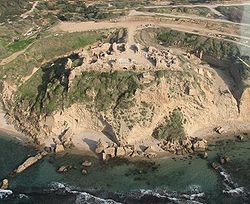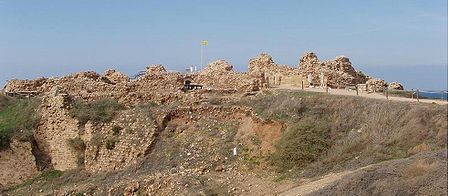
Arsuf
Encyclopedia



Israel
The State of Israel is a parliamentary republic located in the Middle East, along the eastern shore of the Mediterranean Sea...
, about 15 kilometres north of modern Tel Aviv
Tel Aviv
Tel Aviv , officially Tel Aviv-Yafo , is the second most populous city in Israel, with a population of 404,400 on a land area of . The city is located on the Israeli Mediterranean coastline in west-central Israel. It is the largest and most populous city in the metropolitan area of Gush Dan, with...
, on a cliff above the Mediterranean Sea
Mediterranean Sea
The Mediterranean Sea is a sea connected to the Atlantic Ocean surrounded by the Mediterranean region and almost completely enclosed by land: on the north by Anatolia and Europe, on the south by North Africa, and on the east by the Levant...
. The city site, Tel Arsuf, was intensively excavated from 1994. In 2002 it became Apollonia National Park.
In 1995 a new village by the name of Arsuf
Arsuf, Hof HaSharon
Arsuf is a village in central Israel. Located on the Mediterranean coast near Herzliya, it falls under the jurisdiction of Hof HaSharon Regional Council. In 2006 it had a population of 129....
was established to the north of the ancient city.
The town was settled by Phoenicia
Phoenicia
Phoenicia , was an ancient civilization in Canaan which covered most of the western, coastal part of the Fertile Crescent. Several major Phoenician cities were built on the coastline of the Mediterranean. It was an enterprising maritime trading culture that spread across the Mediterranean from 1550...
ns in the 6th or 5th century BC, and named Arshuf after Resheph
Resheph
Resheph was a Canaanite deity of plague and war. In Egyptian iconography Resheph is depicted wearing the crown of Upper Egypt surmounted in front by the head of a gazelle. He has links with Theban war god Montu and was thought of as a guardian deity in battle by many Egyptian pharaohs...
, the Canaan
Canaan
Canaan is a historical region roughly corresponding to modern-day Israel, Palestine, Lebanon, and the western parts of Jordan...
ite god of fertility and the underworld. It was then a part of the Persian Empire and governed from Sidon
Sidon
Sidon or Saïda is the third-largest city in Lebanon. It is located in the South Governorate of Lebanon, on the Mediterranean coast, about 40 km north of Tyre and 40 km south of the capital Beirut. In Genesis, Sidon is the son of Canaan the grandson of Noah...
. Phoenicians of Arshuf produced precious purple dye
Dye
A dye is a colored substance that has an affinity to the substrate to which it is being applied. The dye is generally applied in an aqueous solution, and requires a mordant to improve the fastness of the dye on the fiber....
, derived from murex
Murex
Murex is a genus of medium to large sized predatory tropical sea snails. These are carnivorous marine gastropod molluscs in the family Muricidae, commonly calle "murexes" or "rock snails"...
mollusks, which they exported to the Aegean
Aegean Sea
The Aegean Sea[p] is an elongated embayment of the Mediterranean Sea located between the southern Balkan and Anatolian peninsulas, i.e., between the mainlands of Greece and Turkey. In the north, it is connected to the Marmara Sea and Black Sea by the Dardanelles and Bosporus...
.
During the Hellenistic period it was an anchorage town, ruled by Seleucids and re-named Apollonia, as the Greeks identified Reshef with Apollo
Apollo
Apollo is one of the most important and complex of the Olympian deities in Greek and Roman mythology...
.
Under Roman
Roman Empire
The Roman Empire was the post-Republican period of the ancient Roman civilization, characterised by an autocratic form of government and large territorial holdings in Europe and around the Mediterranean....
rule, the size of the town increased. It was an important settlement between Jaffa
Jaffa
Jaffa is an ancient port city believed to be one of the oldest in the world. Jaffa was incorporated with Tel Aviv creating the city of Tel Aviv-Yafo, Israel. Jaffa is famous for its association with the biblical story of the prophet Jonah.-Etymology:...
and Caesarea along Via Maris
Via Maris
Via Maris is the modern name for an ancient trade route, dating from the early Bronze Age, linking Egypt with the northern empires of Syria, Anatolia and Mesopotamia — modern day Iran, Iraq, Turkey and Syria....
, the coastal road. In 113 AD, Apollonia was destroyed partially by an earthquake, but recovered quickly. The harbor was built, and trade with Italy and North Africa developed.
During the Byzantine
Byzantine Empire
The Byzantine Empire was the Eastern Roman Empire during the periods of Late Antiquity and the Middle Ages, centred on the capital of Constantinople. Known simply as the Roman Empire or Romania to its inhabitants and neighbours, the Empire was the direct continuation of the Ancient Roman State...
period, the town extended to cover an area of 70 acres (283,280.2 m²). In the 5th and 6th century AD it was the second largest city in Sharon valley, after Caesarea, populated by Christian and Samaritans, having an elaborate church and a prosperous glass industry.
In 640 AD, the town was captured by Muslims, and the Semitic
Semitic languages
The Semitic languages are a group of related languages whose living representatives are spoken by more than 270 million people across much of the Middle East, North Africa and the Horn of Africa...
name Arsuf was restored. The town's area decreased to about 22 acres (89,030.9 m²) and, for the first time, it was surrounded by a fortified wall with buttresses, to resist the constant attacks of Byzantine fleets from the sea. Large marketplaces appeared, and pottery production developed. In 809 AD, following the death of Harun al-Rashid
Harun al-Rashid
Hārūn al-Rashīd was the fifth Arab Abbasid Caliph in Iraq. He was born in Rey, Iran, close to modern Tehran. His birth date remains a point of discussion, though, as various sources give the dates from 763 to 766)....
, the local Samaritan community was destroyed and their synagogue ruined.
In 1101 Arsuf fell to a Crusader army led by Baldwin I of Jerusalem
Baldwin I of Jerusalem
Baldwin I of Jerusalem, formerly Baldwin I of Edessa, born Baldwin of Boulogne , 1058? – 2 April 1118, was one of the leaders of the First Crusade, who became the first Count of Edessa and then the second ruler and first titled King of Jerusalem...
. The Crusaders, who called it Arsur, rebuilt the city's walls and created the Lordship of Arsur
Vassals of the Kingdom of Jerusalem
The Crusader state of the Kingdom of Jerusalem, created in 1099, was divided into a number of smaller seigneuries.-Introduction:According to the 13th century jurist John of Ibelin the four highest barons in the kingdom proper were:* the Count of Jaffa and Ascalon...
in the Kingdom of Jerusalem
Kingdom of Jerusalem
The Kingdom of Jerusalem was a Catholic kingdom established in the Levant in 1099 after the First Crusade. The kingdom lasted nearly two hundred years, from 1099 until 1291 when the last remaining possession, Acre, was destroyed by the Mamluks, but its history is divided into two distinct periods....
. In 1187 Arsuf was captured by the Muslims, but fell again to the Crusaders on September 7, 1191 after a battle
Battle of Arsuf
The Battle of Arsuf was a battle of the Third Crusade in which Richard I of England defeated Saladin at Arsuf. Following a series of harassing attacks by Saladin's forces, battle was joined on the morning of 7 September 1191...
between Richard I of England
Richard I of England
Richard I was King of England from 6 July 1189 until his death. He also ruled as Duke of Normandy, Duke of Aquitaine, Duke of Gascony, Lord of Cyprus, Count of Anjou, Count of Maine, Count of Nantes, and Overlord of Brittany at various times during the same period...
and Saladin
Saladin
Ṣalāḥ ad-Dīn Yūsuf ibn Ayyūb , better known in the Western world as Saladin, was an Arabized Kurdish Muslim, who became the first Sultan of Egypt and Syria, and founded the Ayyubid dynasty. He led Muslim and Arab opposition to the Franks and other European Crusaders in the Levant...
.
John of Ibelin, Lord of Beirut
John of Ibelin, the Old Lord of Beirut
John of Ibelin , called the Old Lord of Beirut, was a powerful crusader noble in the 13th century, one of the best known representatives of the influential Ibelin family...
(1177—1236) became Lord of Arsuf in 1207 when he married Melisende of Arsuf
Melisende of Arsuf
Melisende of Arsuf, Sovereign Dame of Arsuf, Lady of Beirut , was an heiress, and the second wife of the powerful Crusader noble John of Ibelin, the Old Lord of Beirut who led the opposition to Emperor Frederick II when he tried to impose Imperial authority in the kingdom of Jerusalem and the...
(born c.1170). Their son John of Arsuf
John of Arsuf
John of Ibelin was the Lord of Arsuf from 1236 and Constable of Jerusalem from 1251. He was a younger son of John I of Beirut. His elder brother, Balian, inherited Beirut. He served as regent of Jerusalem on two occasions: 1253-1254 for Conrad II and 1256-1258 for Conrad III...
(c.1211—1258) inherited the title. The title then passed to John of Arsuf's eldest son Balian of Arsuf
Balian of Arsuf
Balian of Ibelin was the Lord of Arsuf from 1258 until the early 1260s , when he sold it to the Knights Hospitaller. He was the son and successor of John of Arsuf, Constable of Jerusalem...
(1239—1277). He built new walls, the big fortress and new harbor (1241). From 1261, the city was ruled by the Knights Hospitaller
Knights Hospitaller
The Sovereign Military Hospitaller Order of Saint John of Jerusalem of Rhodes and of Malta , also known as the Sovereign Military Order of Malta , Order of Malta or Knights of Malta, is a Roman Catholic lay religious order, traditionally of military, chivalrous, noble nature. It is the world's...
.
In 1265 sultan Baibars
Baibars
Baibars or Baybars , nicknamed Abu l-Futuh , was a Mamluk Sultan of Egypt. He was one of the commanders of the forces which inflicted a devastating defeat on the Seventh Crusade of King Louis IX of France and he led the vanguard of the Egyptian army at the Battle of Ain Jalut in 1260, which marked...
, ruler of the Mamluk
Mamluk
A Mamluk was a soldier of slave origin, who were predominantly Cumans/Kipchaks The "mamluk phenomenon", as David Ayalon dubbed the creation of the specific warrior...
s, captured Arsur, after 40 days of siege. The Mamluks razed the city walls and the fortress to their foundations, fearing a return of the Crusaders. The destruction was so complete that the site was abandoned. In 1596, Ottoman tax registers recorded a village there with 22 families and 4 bachelors and later a village called al-Haram
Al-Haram, Jaffa
Al-Haram, also Sayyiduna Ali or Sidna Ali, was an Arab village in the District of Jaffa in Mandatory Palestine. It was located 16 km north of Jaffa, adjacent to the ruins of the ancient city of Arsuf, also known as Apollonia...
existed adjacent to the ruins until it was depopulated during the 1948 Arab-Israeli War
1948 Arab-Israeli War
The 1948 Arab–Israeli War, known to Israelis as the War of Independence or War of Liberation The war commenced after the termination of the British Mandate for Palestine and the creation of an independent Israel at midnight on 14 May 1948 when, following a period of civil war, Arab armies invaded...
.
External links
- http://www.tau.ac.il/humanities/archaeology/projects/proj_apollonia.html The Official Apollonia-Arsuf Archaeological Project
- Archaeological exploration of Arsuf Israel Ministry of Foreign Affairs
- Apollonia National Park Gems of Israel
- Pictures of Apollonia-Arsuf Holy Land Pictures

